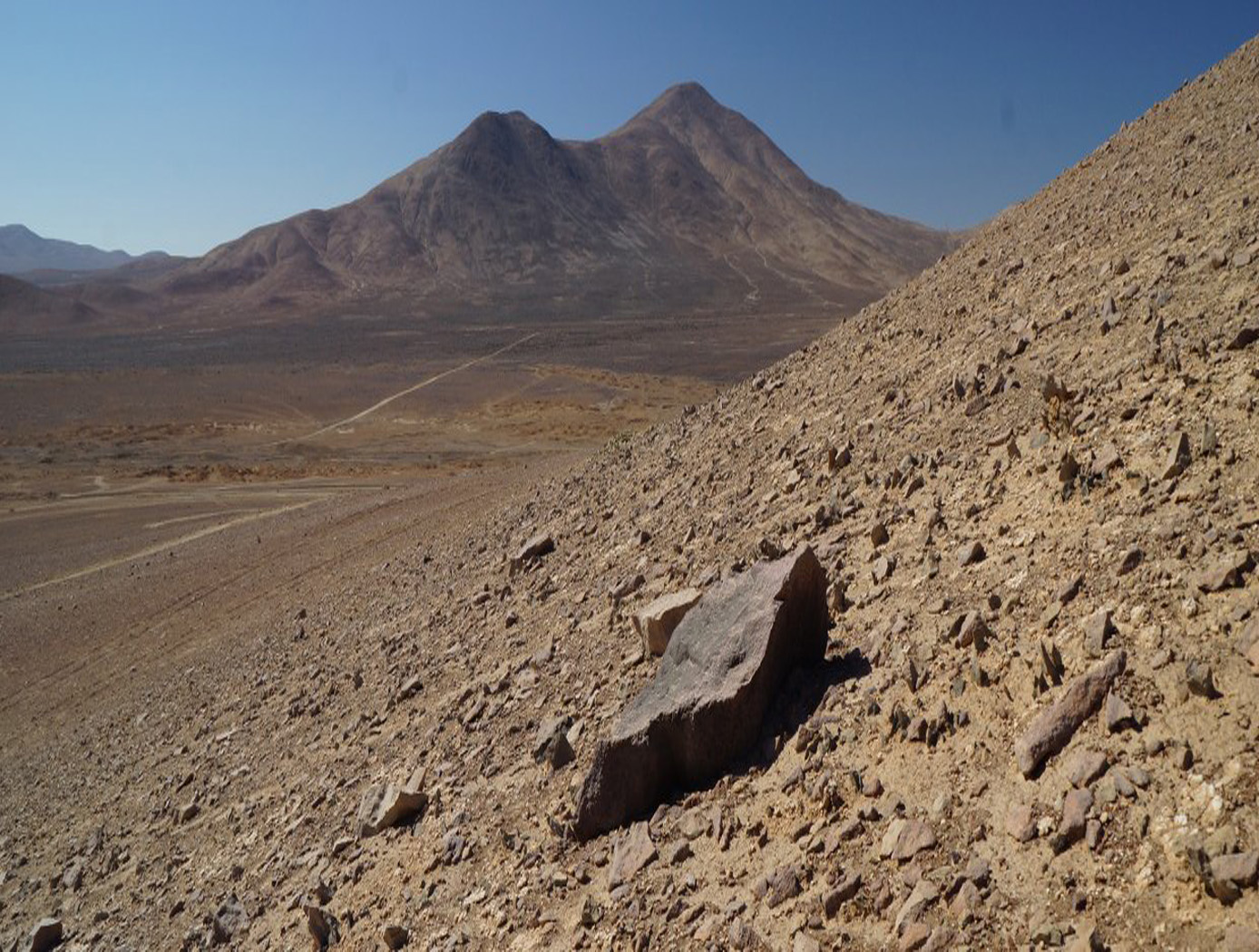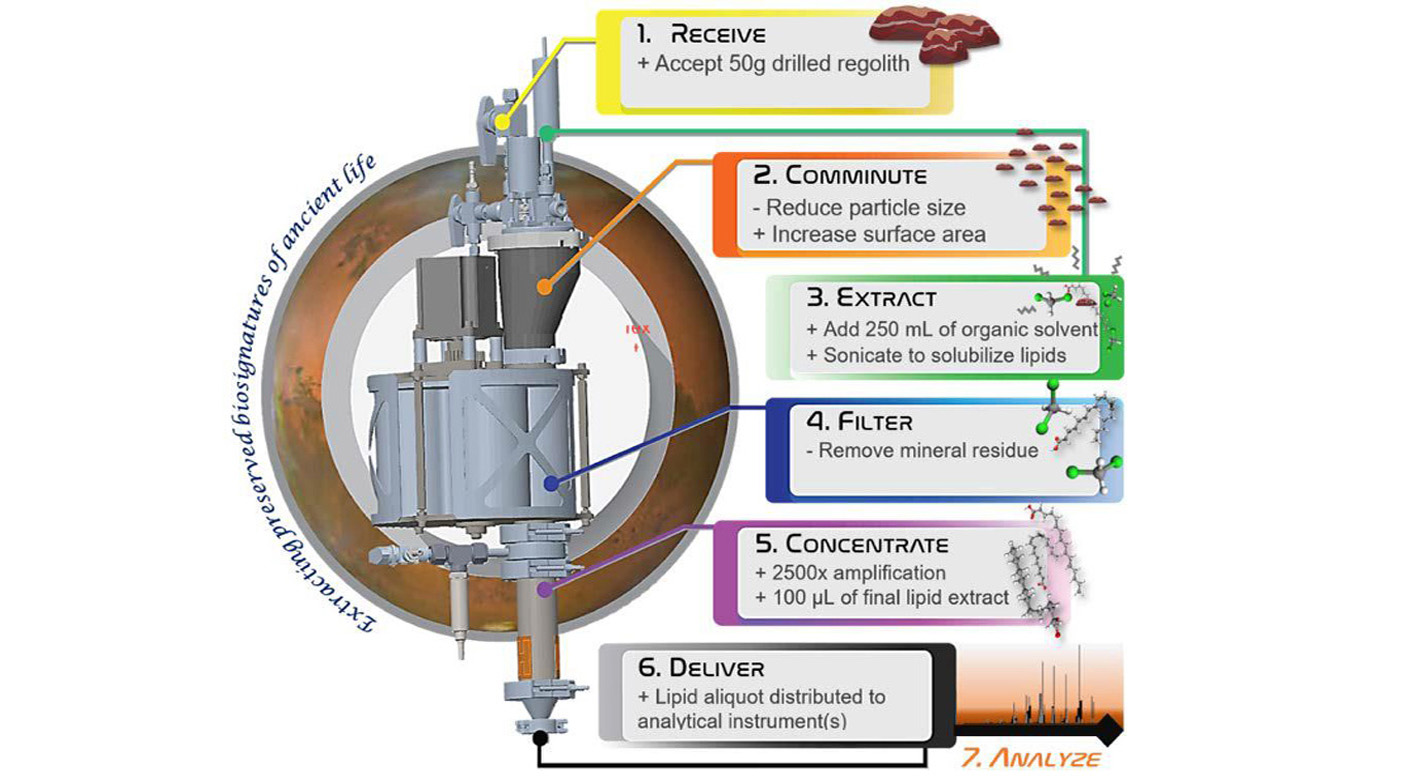Extractor for Chemical Analysis of Lipid Biomarkers in Regolith (ExCALiBR)
Mechanical and Fluid Systems
Extractor for Chemical Analysis of Lipid Biomarkers in Regolith (ExCALiBR) (TOP2-302)
An autonomous, miniaturized fluidic system for lipid analysis
Overview
Lipids are organic molecules used by all life on Earth, primarily for building membranes that encompass cells. The analysis of lipid biomarkers has gained increasing importance within environmental and archaeological fields because biomarkers are representative of particular plant and animal sources. Proven “gold standard” laboratory techniques for lipid biomarker extraction are laborious, with many opportunities for human error. As a solution, NASA Ames Research Center has developed a novel technology that provides an autonomous, miniaturized fluidic system for lipid analysis. The technology, in a single instrument, can accept an unprocessed soil, rock, or ice sample, comminute the sample, extract lipids via sonication and blending, filter out mineral residue, concentrate the analyte, and deliver the aliquot to downstream analytical instruments for molecular characterization, without requiring intervention from a human operator.
The Technology
The technology provides miniaturized techniques for extracting trace amounts of organic molecules (lipids) from natural samples. It operates as an autonomous, miniaturized fluidic system, integrating lab techniques for lipid analysis while minimizing reagent volumes and concentrating organics for analysis, thereby increasing signal-to-noise ratios by orders of magnitude. The non-aqueous fluidic system described herein for astrobiological and life-detection missions (either in situ or returned sample) is configured to extract lipid organics from regolith using (1) a fluidic sample processor made of materials compatible with organic solvents and (2) a machine-learning system to select processing steps and parameters to maximize lipid yield. A critical gap is bridged by integrating technologies into a system that replicates analytical lab procedures autonomously on a spaceflight instrument scale with fidelity to original lab techniques. Automated fluidic devices combine controlled handling of liquids with sequential operations and parallelization of replicate processes. By designing such systems to closely interface with both sample-delivery and analytical measurement systems, laboratory analyses are automated. The technology adapts best practice laboratory methods for lipid analysis, overcoming analytical challenges like low organic abundance, interference of minerals/salts, and degradation of origin-diagnostic molecular structures. The extraction and concentration techniques from rock/soil samples can be applied to any biomarkers by changing the solvent, temperature, and agitation.


Benefits
- Conserve origin-diagnostic lipid structures/patterns by maintaining them in the liquid phase
- Reduce signal-to-noise interference by extracting lipids from the mineral matrix and filtering out minerals
- Reduces potential for contamination during sample handling and processing
- Combines the seven steps within sample collection, extraction, filtration, and chemical preparation for downstream analysis into one instrument
- Saves cost and time - operator independent; and what previously required a human ~8 hours to complete would now take only ~1-2 hours
- Performance benefits: e.g., lower labor hours, more automation, reduced consumables, quick turnaround for sample analysis, and allowance for measurements at field site
- Prototype was fabricated from commercial off-the-shelf (COTS) parts
- Can be deployed on other planetary surfaces with simple modifications to extraction parameters such as solvent polarity, temperature and pressure
Applications
- Oil and petroleum industry - analyzing oil trapped in geological deposits and exploration technologies
- Petroleum protecting, both in the area of unconventional oil and gas where micro-scale matters, as well as for sub-sea deployment systems and borehole environments
- Can be used to detect lipids in Earth soil to determine presence of petrochemicals; to detect oil spills or other contamination
- Life detection in an astrobiologically significant sample in future missions to Mars, Enceladus, and/or Europa
- Analysis of natural, complex organic material preserved in soils and rock
- Integrated into benchtop analysis or onto an unmanned terrestrial rover for field exploration
- Integrated into an aquatic system for petroleum studies with only minor modifications
Technology Details
Mechanical and Fluid Systems
TOP2-302
ARC-18478-1
https://ui.adsabs.harvard.edu/abs/2021LPI....52.2634W/abstract
|
Tags:
|
Similar Results

Microfluidics Pressure-Based Switching and Valving Array
The innovative technology from Ames acts as a microfluidics switch array, using combinations of pressure and flow conditions to achieve specific logic states that determine the sequences of sample movement between microfluidic wells. This advancement will enable automation of complex laboratory techniques not possible with earlier microfluidics technologies that are designed to follow predetermined flow paths and well targets. This novel method also enables autonomous operations including changing the flow paths and targeting well configurations in situ based on measured data decision parameters. This microfluidic system can be reconfigured for use in various experimental applications, requiring only an adjustment of the programmed pressure sequencing, reducing the need for custom design and development for each new application. For example, this technology could provide the ability to selectively constrain or move biological specimens in the experimental wells, allowing evolutionary studies of model organisms in response to various stressors, evaluation of different growth conditions on biological production of antibodies or other small molecule therapeutics, among other potential applications. Likewise, this platform can be used to foster time-dependent, step-wise, chemical reactions, which could be used for novel chemical processes or in situ resource utilization.

MiniTOCA Facilitates Automated Water Analysis
Environmental Control and Life Support Systems (ECLSS) used for extended space missions must recover and process wastewater to provide potable water for crew consumption and oxygen generation. Exploration mission spacecraft will have a smaller crew than the ISS, meaning demands would typically be less than what full-featured commercial TOC analyzers are designed to provide. Current analyzer technology also has limitations and uncertainties for spaceflight integration, such as part traceability, reliability, material properties for flammability or off-gassing, software and interface that are inconsis-tent with spaceflight needs, human factors, and structural reliability.
The MiniTOCA provides a compact solution to the performance demands of onboard water quality analysis for crewed exploration missions through a unique core technology process that facilitates the detection of trace organic compounds in a water sample. It utilizes an ultra-violet oxidation method to activate the dissolved oxygen in the water which results in oxidation of the organic chemicals into carbon dioxide. The carbon dioxide is then measured by a Miniature Tunable Laser Spectrometer (MTLS) by sweeping the carbon dioxide out of the water in a gas / liquid separator using nitrogen gas.
This novel process allows for small system sample volumes, small overall size/mass, zero consumables, low average power con-sumption (less than 60W), projected long-life (~10 years), and reliable analytical performance – all addressing critical performance gaps within the current TOC analyzer industry. Lab and environmental testing demonstrated that the MiniTOCA’s architecture is both feasible and is excellent in performance.
Potential commercial applications for the MiniTOCA include, but are not limited to, ultra-pure water (UPW) systems; remote, mobile, and distributed environmental water quality monitoring; and specialized industrial process control. Technologies comprising the device lend themselves to miniaturization and are forward leaning in exploration applications. The MiniTOCA is scheduled to be flown and imple-mented aboard the ISS in late 2025.

Self-Contained Device Isolates Biological Samples
JSC's technology provides hazard-free, microgravity-compatible hardware for DNA/RNA isolation. It also allows PCR analysis to be used outside the lab in environments where pipetting is difficult and/or where hazardous chemicals must be confined to an enclosed container, such as military settings and remote clinical operations.
This self-contained device for isolating DNA/RNA, proteins, and cells is a component system that includes syringes and pistons, membranes of different capacities, reagents, four-way valves, and small pumps. The pre-filled reagents are the same as those used in conventional PCR laboratory isolation analysis. The DNA and RNA isolation kits are novel and process small sample amounts using a self-enclosed and pipette-free technique. Multiple kits can be stacked to allow several samples to be processed simultaneously. The system can be used in conjunction with existing analysis modules, such as commercially available DNA instruments. The process can be fully automated and programmed and can potentially be applied to other biological processes. The JSC innovation will permit the extension of laboratory isolation protocols to many applications.
This NASA Technology is available for your company to license and develop into a commercial product. NASA does not manufacture products for commercial sale.

Rapid Nucleic Acid Isolation Method and Fluid Handling Devices
Gene expression analysis measures the activity of genes and reveals valuable information about the internal states of living cells. NASA Ames has developed a novel system for conducting quantitative, real-time gene expression analysis that not only significantly improves the sample preparation procedures and provides a quick, cost-effective solution needed in a laboratory, but also minimizes the risk of RNA contamination and degradation. The invention, a novel assay methodology and suite of devices have been developed to isolate nucleic acids from Prokaryotic and Eukaryotic cells and prepare samples for Reverse Transcriptase - quantitative Polymerase Chain Reaction (RT-qPCR) analysis.
The invention consists of a method to extract and purify nucleic acids from biospecimen that does not require organics or toxic chemicals, and provides containment for the liquids. The assay employs an aqueous-based non-alcohol method that yields robust RNA quality; and PCR reaction tubes that are pre-loaded with stabilized lyophilized reagents designed to perform RT-qPCR analysis - all in all enabling rapid, cost effective, and portable manual operation in the laboratory or remote field environments. This innovative technology greatly reduces preparation time to less than 10% of the time it would take using standard techniques. This technology could be used with any commercial quantitative Polymerase Chain Reaction (qPCR) machine.

Portable Medical Diagnosis Instrument
The technology utilizes four cutting-edge sensor technologies to enable minimally- or non-invasive analysis of various biological samples, including saliva, breath, and blood. The combination of technologies and sample pathways have unique advantages that collectively provides a powerful analytical capability. The four key technology components include the following: (1) the carbon nanotube (CNT) array designed for the detection of volatile molecules in exhaled breath; (2) a breath condenser surface to isolate nonvolatile breath compounds in exhaled breath; (3) the miniaturized differential mobility spectrometer (DMS) -like device for the detection of volatile and non-volatile molecules in condensed breath and saliva; and (4) the miniaturized circular disk (CD)-based centrifugal microfluidics device that can detect analytes in any liquid sample as well as perform blood cell counts. As an integrated system, the device has two ports for sample entry a mouthpiece for sampling of breath and a port for CD insertion. The breath analysis pathway consists of a CNT array followed by a condenser surface separating liquid and gas phase breath. The exhaled breath condensate is then analyzed via a DMS-like device and the separated gas breath can be analyzed by both CNT sensor array again and by DMS detectors.



